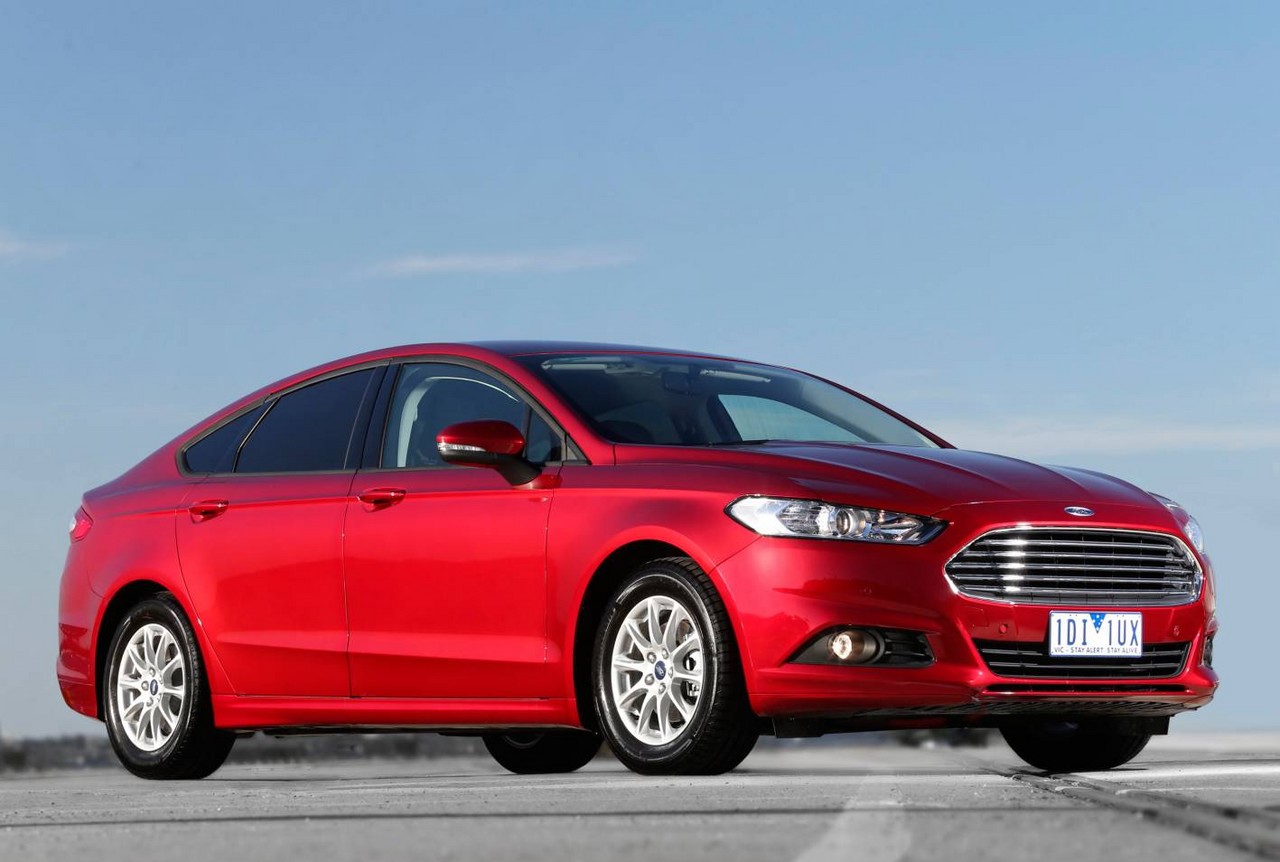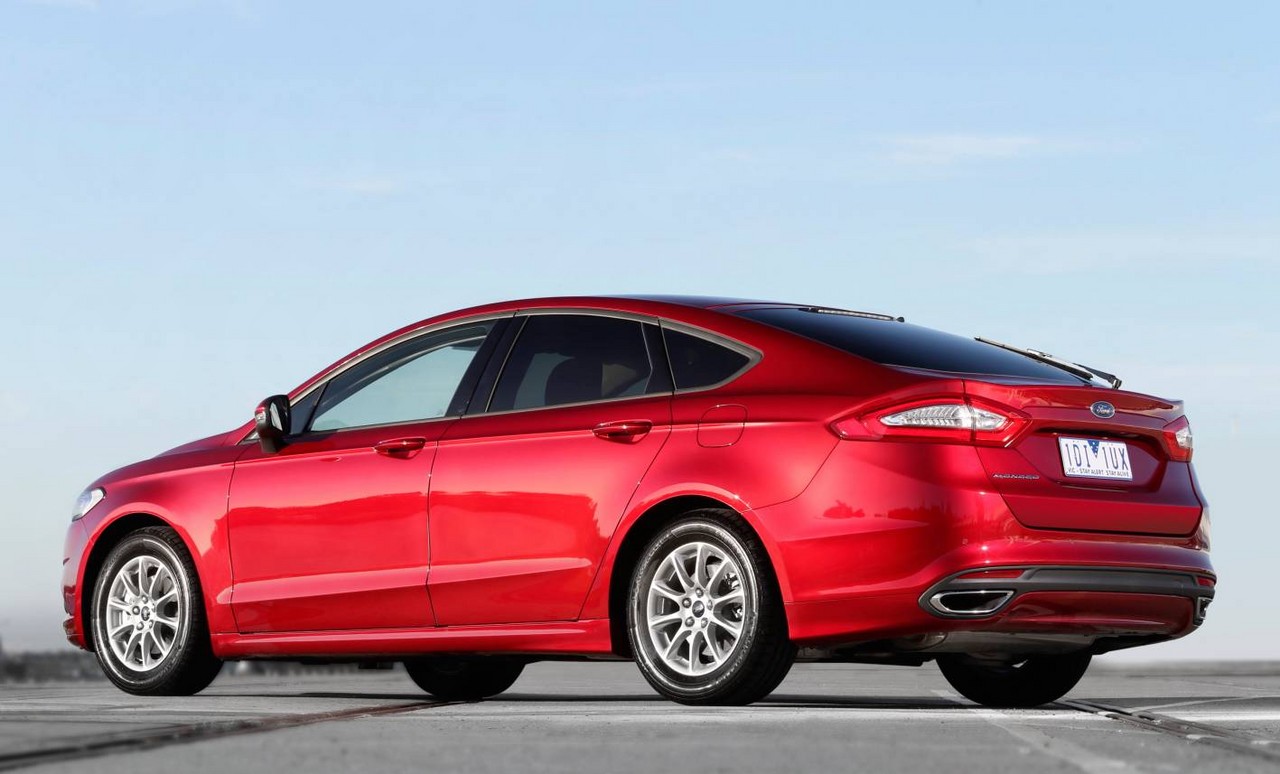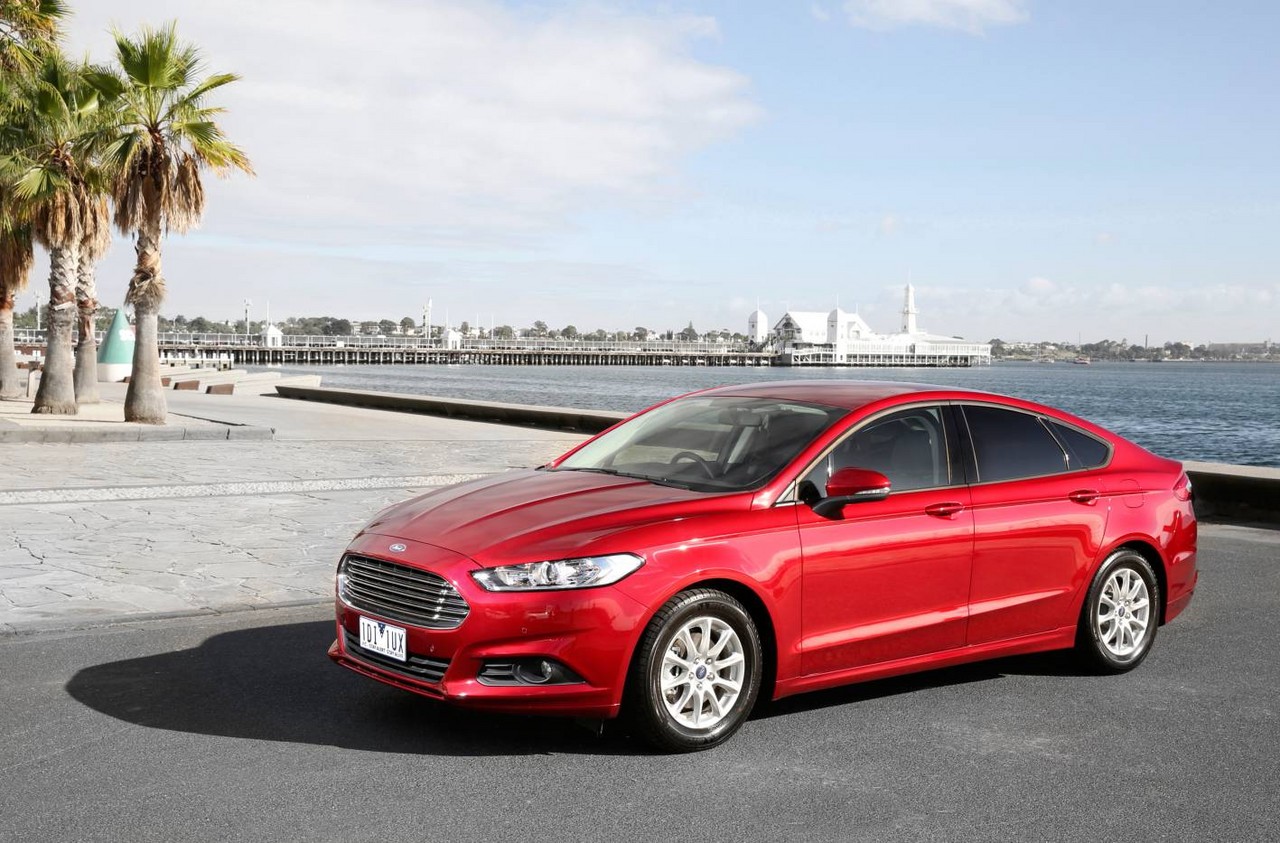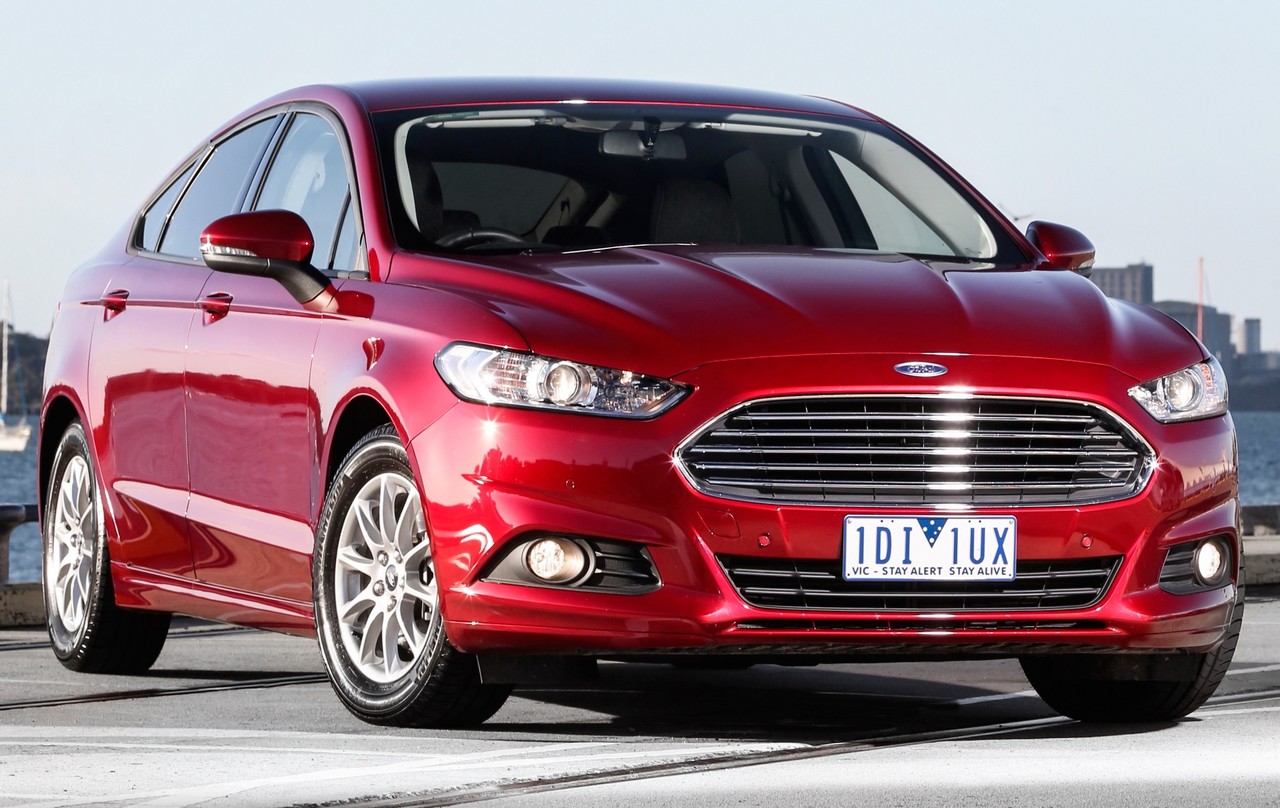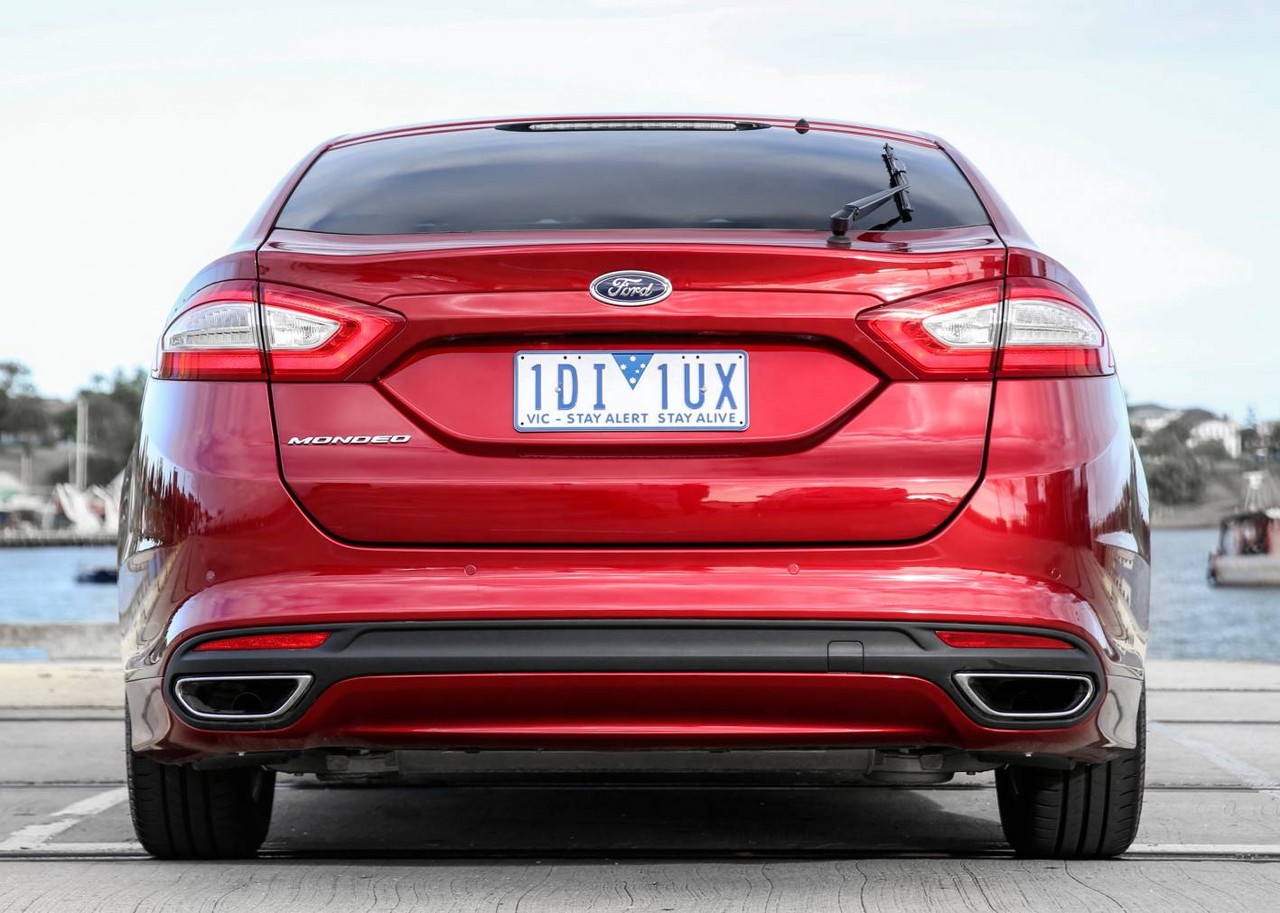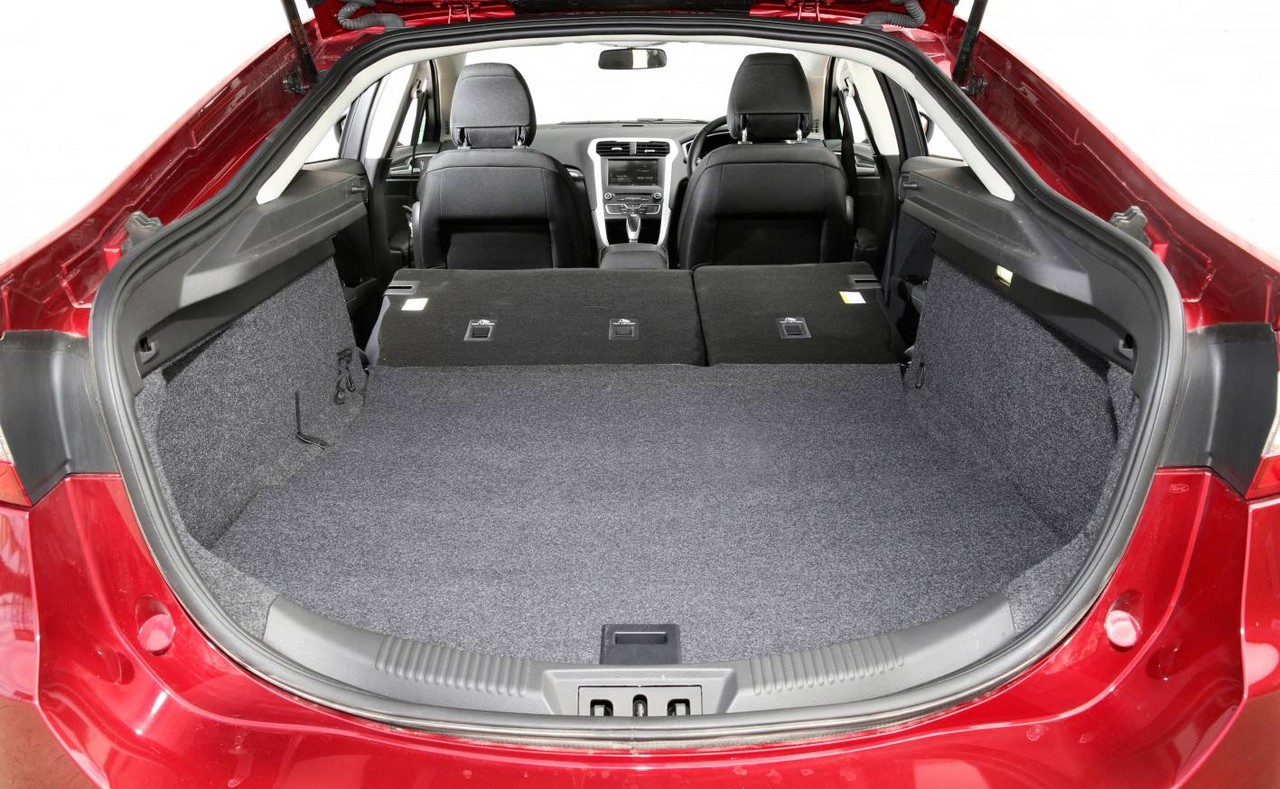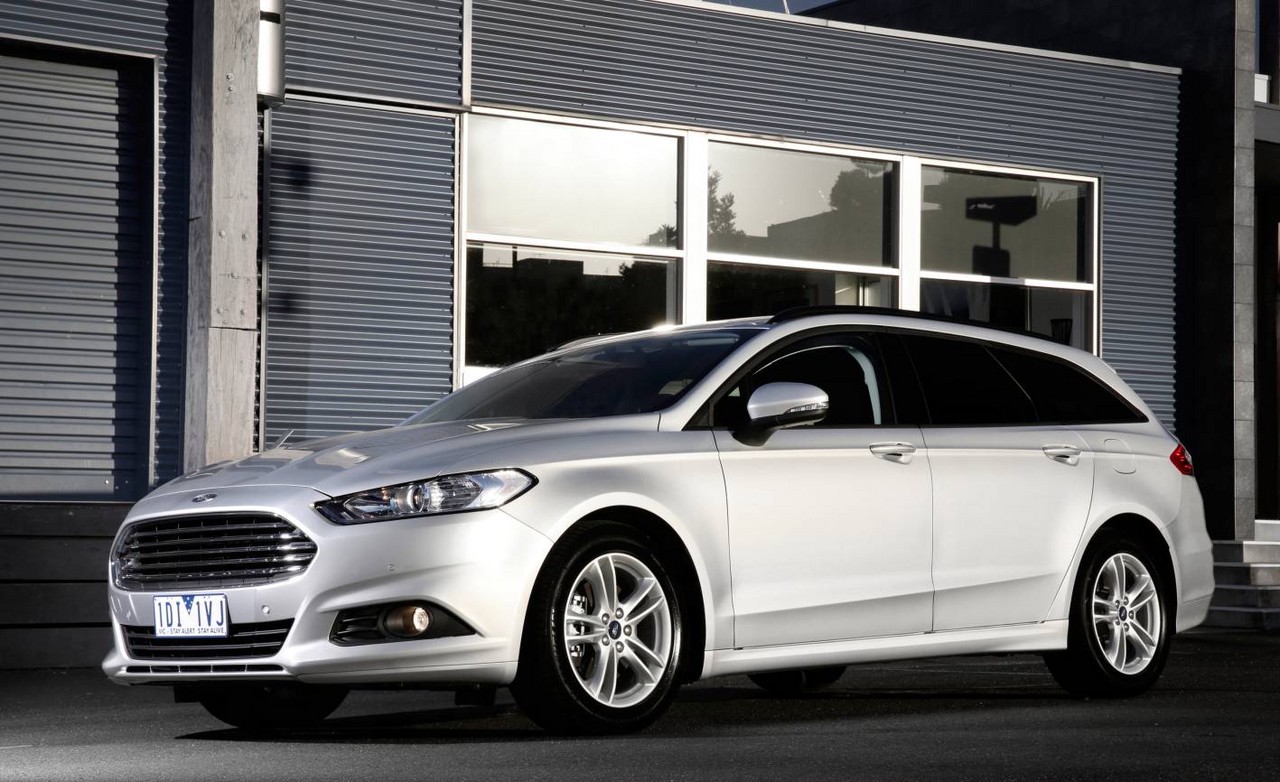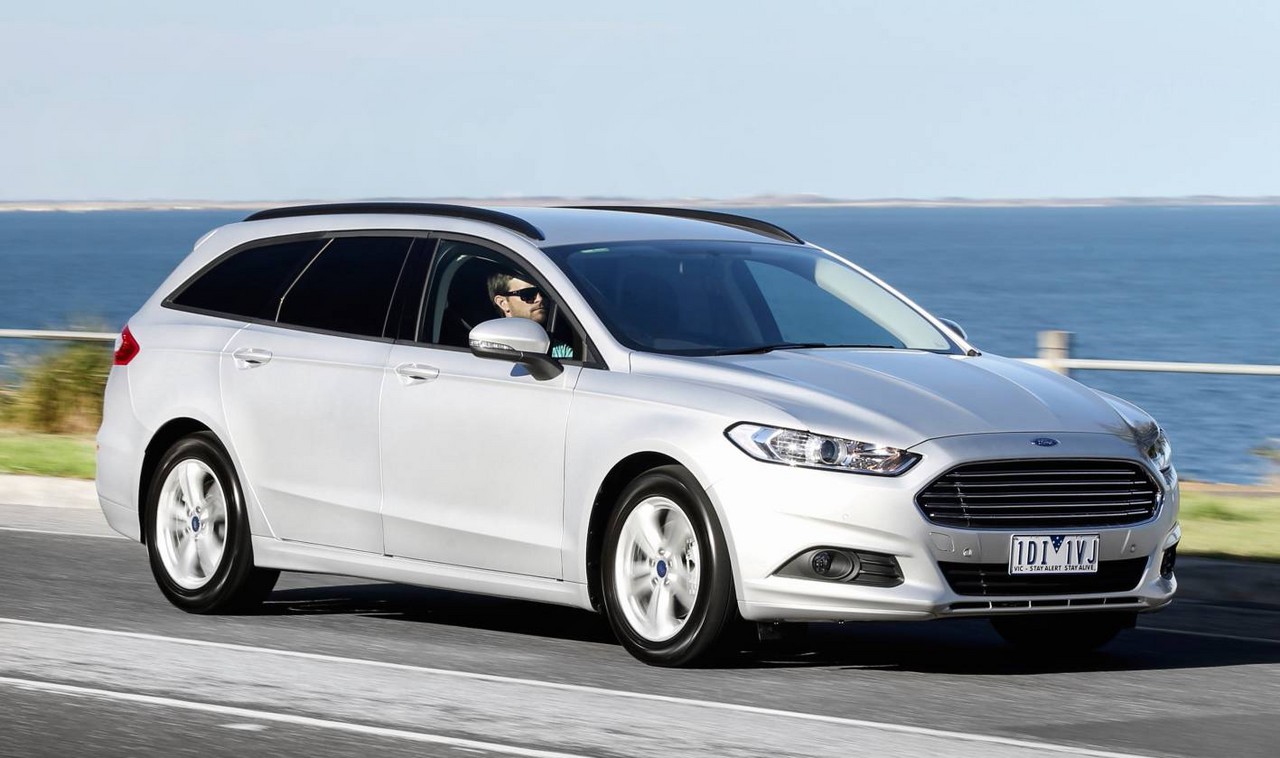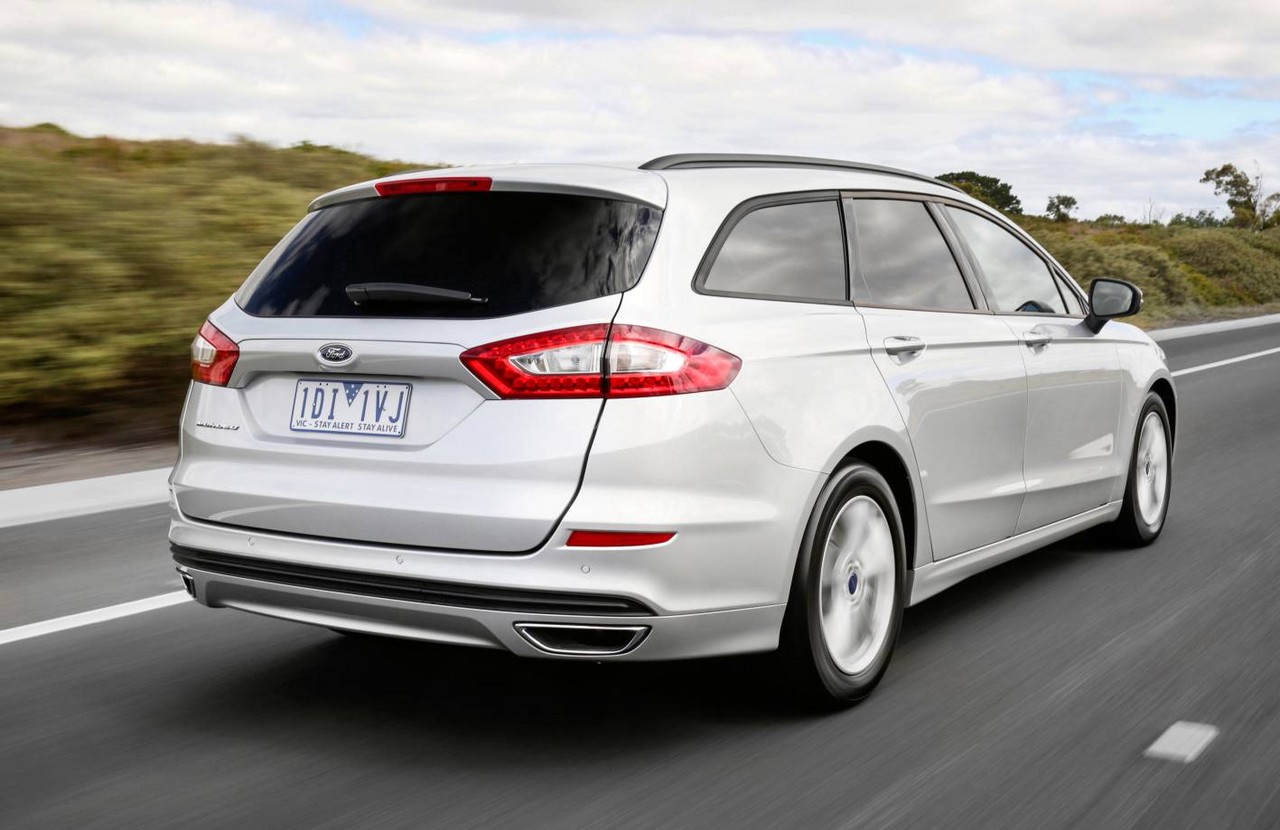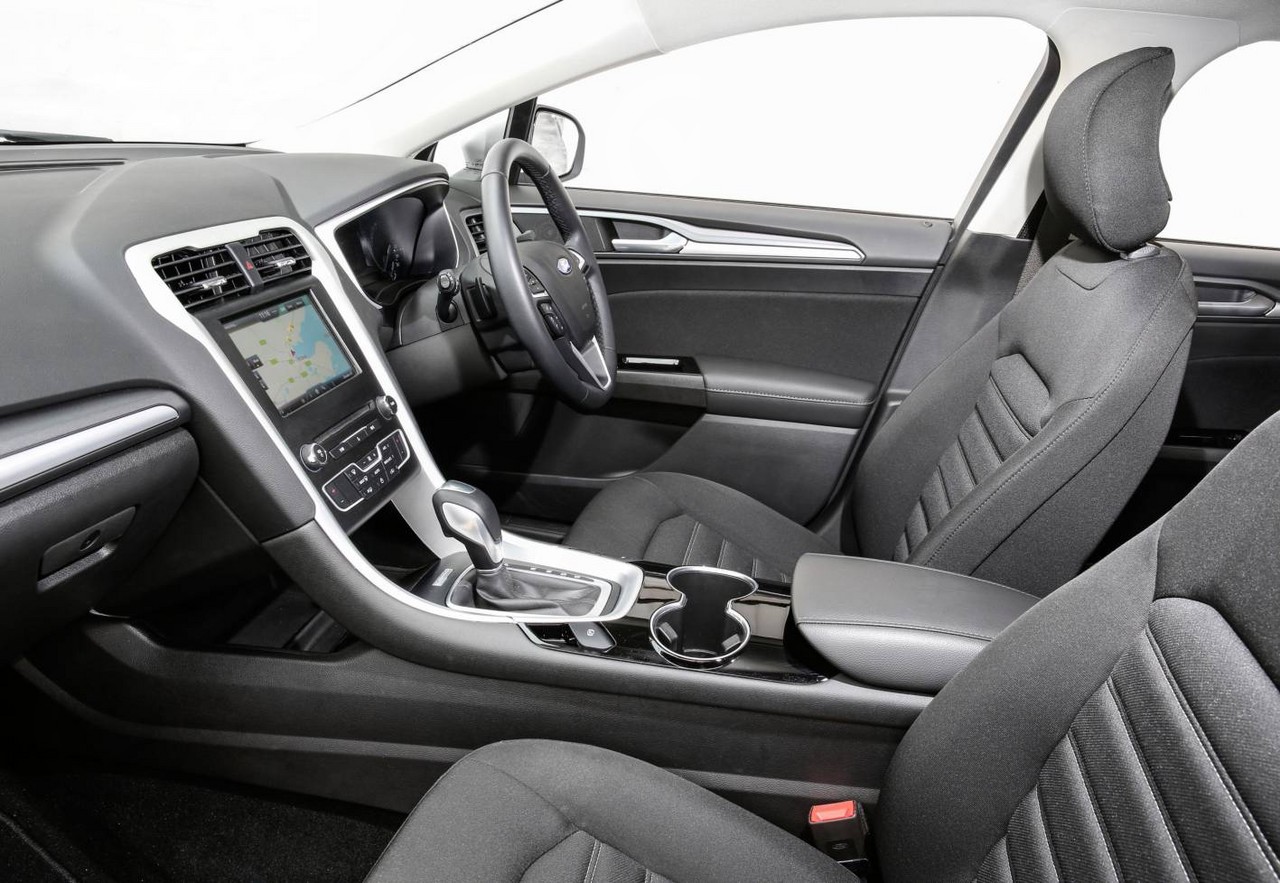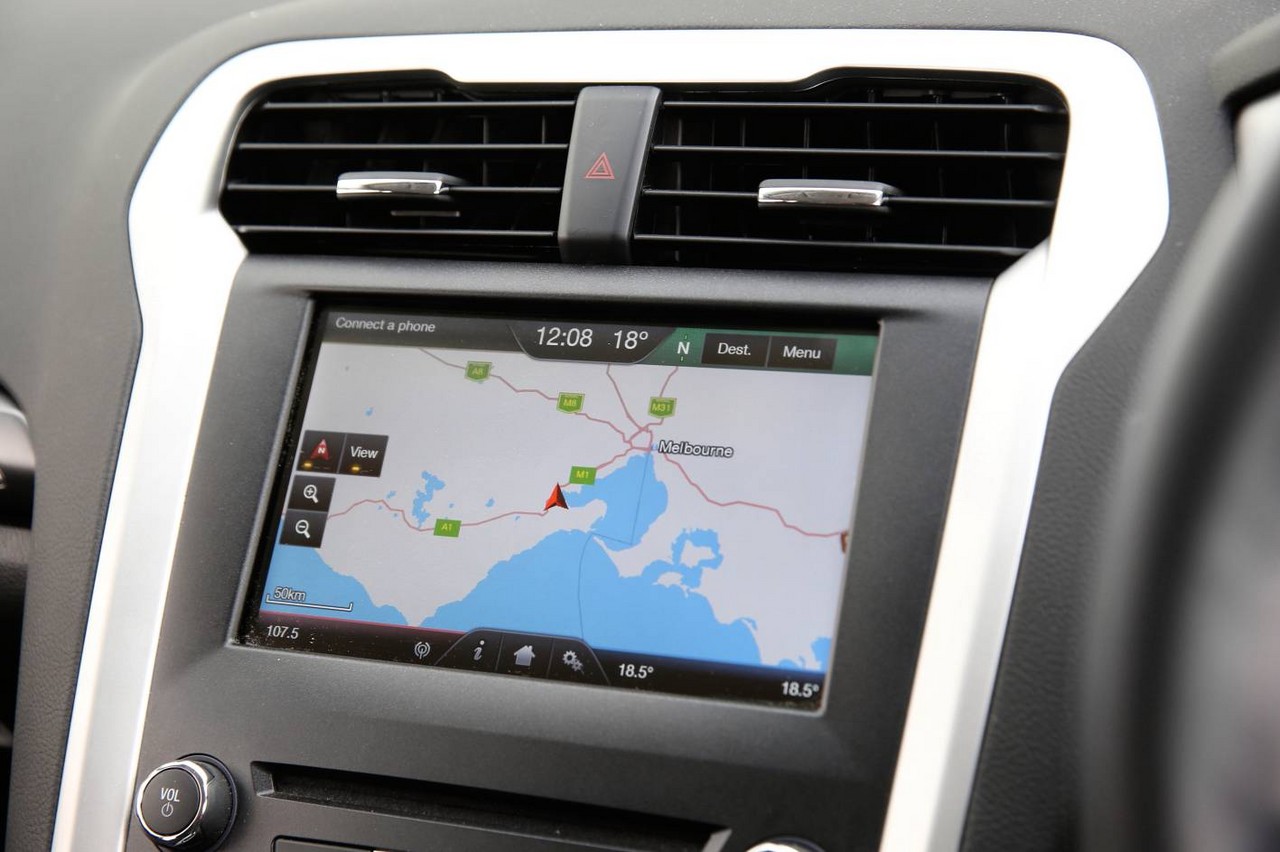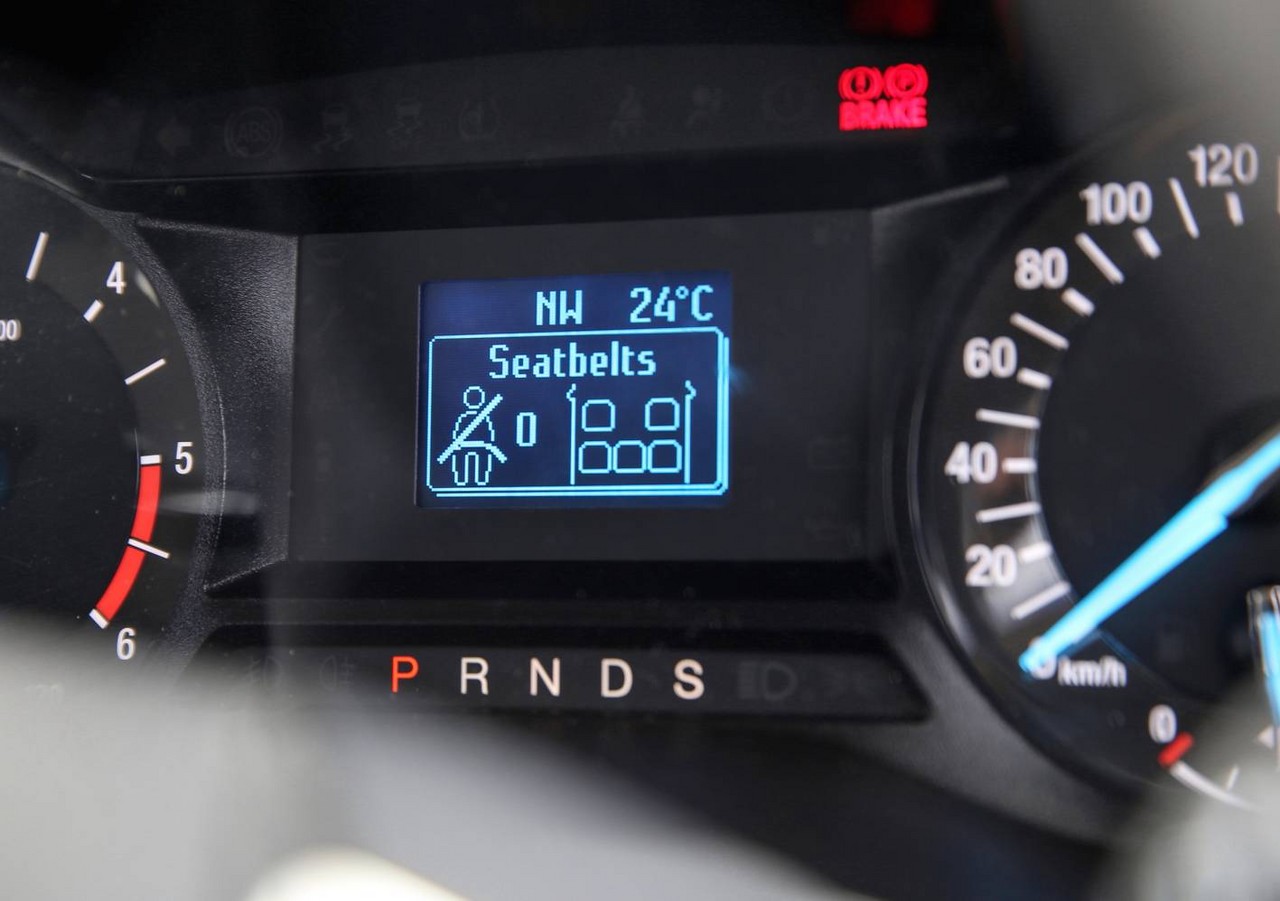
- Refined ‘EcoBoost’ petrol engines
- Frugal 2.0-litre turbo-diesel engine
- Comfortable seats and ride
- Spacious and quiet interior
- Overly assisted steering lacks feedbacks
- Dynamics fall short of Mazda GJ Mazda6
- For liftback, limited rear seat headroom
- Cheap interior plastics
Review: Ford MD Mondeo (2015-on)
Overview
Released in Australia in May 2015, the Ford Mk.5 Mondeo was offered as a mid-size liftback or wagon. Manufactured in Valenica, Spain, the front-wheel drive Mondeo was powered by 2.0-litre turbocharged ‘EcoBoost’ petrol or 2.0-litre ‘Duratorq’ turbo-diesel engines. As per the table below, the Mk.5 Mondeo range consisted of Trend, Ambiente and Titanium variants.
EcoBoost petrol and Duratorq turbo-diesel engines
Of the engines,
- The 2.0-litre EcoBoost four-cylinder petrol engines had a cast aluminium block and cylinder head, a Borg Warner K03 turbocharger, direct injection, double overhead camshafts, four valves per cylinder, twin independent variable camshaft timing and a compression ratio of 10.0:1; and,
- The 2.0-litre Duratorq TDCi diesel engine had a cast aluminium block and cylinder head, variable geometry turbocharger, intercooler, common-rail direct injection, piezo-electric injectors, twin belt-driven camshafts (with the inlet camshaft connected to a cam belt with the exhaust camshaft indirectly linked via a timing chain), four valves per cylinder and a compression ratio of 16.7:1.
Ford’s ‘Auto Start-Stop’ technology, which enabled the engine to shut down when the vehicle was stationary to conserve fuel, was standard across the range.
While the EcoBoost engine was available with a six-speed automatic transmission, the Duratorq TDCi engine was offered with a six-speed double clutch transmissions (Ford’s ‘PowerShift’).
| Body | Engine | Trans. | Variant | Peak power | Peak torque |
|---|---|---|---|---|---|
| Liftback | 2.0-litre EcoBoost turbo petrol I4 | 6sp auto | Ambiente | 149 kW at 6000 rpm | 345 Nm at 2700-3500 rpm |
| Trend, Titanium |
177 kW at 5300 rpm | 345 Nm at 2300-4900 rpm | |||
| 2.0-litre turbo-diesel I4 (TDCi) |
6sp DCT | Ambiente, Trend, Titanium |
132 kW at 3750 rpm | 400 Nm at 2000-2500 rpm | |
| Wagon | 2.0-litre EcoBoost turbo petrol I4 | 6sp auto | Ambiente | 149 kW at 6000 rpm | 345 Nm at 2700-3500 rpm |
| 2.0-litre turbo-diesel I4 (TDCi) |
6sp DCT | Ambiente, Trend, Titanium |
132 kW at 3750 rpm | 400 Nm at 2000-2500 rpm |
Chassis and dimensions
According to Ford, the Mk.5 Mondeo was the first automotive application of hydro-formed high strength steel, with these steels used for the A-pillars, B-pillars and roof rails. Hydro-forming used high-pressure hydraulic fluid to press metal into more complex shapes than was possible using traditional stamping methods, yet provided better strength-to-weight ratios and bending rigidity. Overall, 61 per cent of the Mk.5 Mondeo’s body structure consisted of high strength steels.
Other developments for the Mk.5 Mondeo included:
- An anti-roll bar that was designed to limit transmission travel in a frontal impact, minimising steering rack movement;
- Sill rocker panels made of martensitic boron steel for improved side improtection;
- An integrated rear underbody wheel-arch-to-rail connector that increased torsional rigidity by up to 25 per cent (compared to a traditional design); and
- To conserve mass, four- and five-door models had a magnesium inner tailgate structure that was around 40 per cent lighter than its steel equivalent.
According to Ford, the Mk.5 Mondeo body achieved a 10 percent increase in torsional stiffness relative to the Mk.4 Mondeo . Compared to its predecessor, the Mk.5 Mondeo sedan was 25 mm longer (at 4869 mm), 34 mm narrower (1852 mm), 24 mm lower (1476 mm) and had the same length wheelbase (2850 mm).
Suspension
The Mk.5 Mondeo had MacPherson strut front suspension and multi-link rear suspension, though the latter was revised and had an ‘integral link’ design rather than unequal length control arms. For wagon models, the rear suspension had a self-levelling function that maintained an optimal ride height for comfort and handling regardless of load. Furthermore, the Mondeo Titanium had Continuous Damping Control (i.e. continuously adjusting, electronically-controlled dampers).
Steering
The Mk.5 Mondeo had an electric, power-assisted steering system that enabled the driver to select from ‘Comfort’, ‘Normal’ and ‘Sport’ settings.
Safety equipment
Standard safety equipment for the Ford Mk.5 Mondeo included dual front airbags, a driver’s knee airbag, front and rear side airbags, full-length curtain airbags, ABS, electronic brake force distribution, brake assist, electronic stability control, traction control and front seatbelts with pretensioners and load limiters.
As standard, the Mondeo was fitted with inflatable rear seatbelts which were designed to reduce head, neck and chest injuries. In the event of an accident, the belt would expand within 40 milliseconds over an occupant’s torso and shoulder to disperse crash forces across an area five times greater than that achieved by a conventional seatbelt.
The Mondeo Trend was further equipped with:
- Adaptive Cruise Control (ACC): a radar-based cruise control system which maintained a pre-set distance from the vehicle ahead. If the system detected that the vehicle ahead was decelerating or too close, ACC autonomously applied the brakes to maintain that distance. Once the road was clear, ACC would accelerate the vehicle back to the desired cruising speed; and,
- Active City Stop: operating at speeds of up to 40 km/h, Active City Stop would automatically apply the brakes to mitigate or avoid a collision with a vehicle ahead. Generally, collisions at speeds of up to 15 km/h could be prevented and the severity of impacts between 15 km/h and 40 km/h reduced.
Beyond this, the Mondeo Titanium added:
- Blind Spot Detection: a sensor-based system which displayed an alert in the side mirror when a vehicle entering the driver’s blind-spot. Furthermore, a cross-traffic alert provided a warning if traffic was detected approaching from the sides of the vehicle (such as when reversing out of a parking space);
- Lane Keeping Aid and Assist (LKA): used a forward facing camera to detect if the Mondeo unintentionally drifted out of its lane. If this occurred, the steering wheel would vibrate to alert the driver and automatically apply steering torque to return the vehicle to its lane (unless the indicator was on); and,
- Driver Impairment Monitor (DIM): observed driver behaviour such as lane positioning for signs of fatigue. If detected, a chime would sound to alert the driver to stop and rest.
Brakes
The Mondeo liftback had 300 mm by 28 mm vented front brake discs and 302 mm by 11 mm solid rear discs. The Mondeo wagon, however, had 316 mm by 28 mm vented front brake discs and 316 mm by 11 mm solid rear discs.
Euro NCAP testing
In Euro NCAP testing , the 2014 Ford Mk.5 Mondeo Wagon 2.0 TDCi received a five star safety rating which included an 86 per cent adult occupant protection rating and an 82 per cent child occupant protection rating. In the offset crash test, protection of the driver’s head, neck, chest, thighs and feet were rated as good, though lower leg protection was rated as adequate (i.e. a slight risk of serious injury). In the side impact test, protection of the driver’s chest was rated as adequate though other areas were rated as good. In the more severe pole test, chest protection was rated as marginal and abdomen protection as adequate.
Under ANCAP’s methodology , this testing resulted in a five star adult occupant protection rating with a score of 36.07 out of 37.
Features: Mondeo Ambiente
Standard features for the Mondeo Ambiente included 16-inch alloy wheels, Ford’s ‘SYNC 2’ connectivity system (tuned for Australian accents) with an eight-inch colour touchscreen, digital radio and Bluetooth connectivity including audio streaming, satellite navigation, auxiliary inputs (USB, RCA and SD card) dual-zone climate control air conditioning, cruise control, cloth seats, front fog lights, daytime running lights, front and rear parking sensors, 60:40 split and folding rear seats, a leather-wrapped steering wheel with gearshift paddles, remote central locking, power windows and heated mirrors, tilt and telescopic steering wheel adjustment, privacy glass, a trip computer and an immobiliser.
As standard, the Mondeo also had a programmable ‘MyKey’ which enabled parents to set limits – such as maximum sound system volume or speed limits – for younger drivers when they used that key.
Features: Mondeo Trend
Compared to the Mondeo Ambiente, the Mondeo Trend was further equipped with 17-inch alloy wheels, partial leather seats, ten-way power adjustable and heated front seats, driver’s seat memory settings, a rear view camera, automatic headlights, rain-sensing wipers, power folding door mirrors, a proximity key (for keyless entry), an auto-dimming rear view mirror, puddle lamps and dual exhausts.
Features: Titanium
The range-topping Mondeo Titanium was distinguished by its 18-inch alloy wheels, full leather seats, front sports seats, heated rear seats, adaptive LED headlights, daytime LED running lights, a power adjustable steering column, a panoramic glass roof, a driver’s side electrochromatic mirror, ambient lighting, aluminium pedal covers, scuff plates and bodykit (front and side skirts); wagon models will also have a power-operated tailgate.
As standard, the Mondeo Titanium also featured Ford’s ‘Enhanced Park Assist’ which used sensors to detect parking spaces and provide automated steering into both parallel and perpendicular parking spaces.
April 2017: Ford Mondeo update
In April 2017, the Ford Mondeo range was updated with new wheel and tyre combinations. Specifically,
- The Mondeo Ambiente was fitted 7.5J x 17-inch alloy wheels with 235/50 R17 tyres for both the liftback and wagon (previously 6.5J x 16-inch alloy wheels for the Mondeo liftback);
- The Mondeo Trend was fitted with 8.0J x 18-inch five-spoke alloy wheels with 235/45 tyres (previously 17-inch wheels); and,
- The Mondeo Titanium was fitte with 8.0J x 19-inch, five-spoke alloy wheels with 235/40 Continental tyres (previously 18-inch wheels).
Furthermore, the ‘SYNC 2’ connectivity system was replaced by ‘SYNC 3’ which provided faster performance, a revised graphical interface and smartphone integration via Apple CarPlay and Android Auto. Finally, a new ‘Metalicious’ paint colour was introduced, described by Ford as ‘a warm tinted clear-coat silver with a high degree of colour flip’.
Related links
- Brochure: Ford MD Mondeo (March 2015)
- Brochure: Ford MD Mondeo (August 2016)
- Behind the Wheel: 2017 Ford Mondeo Ambiente Review
- Ford Australia: Ford Mondeo
- Wikipedia.org: Ford Mk.5 Mondeo
